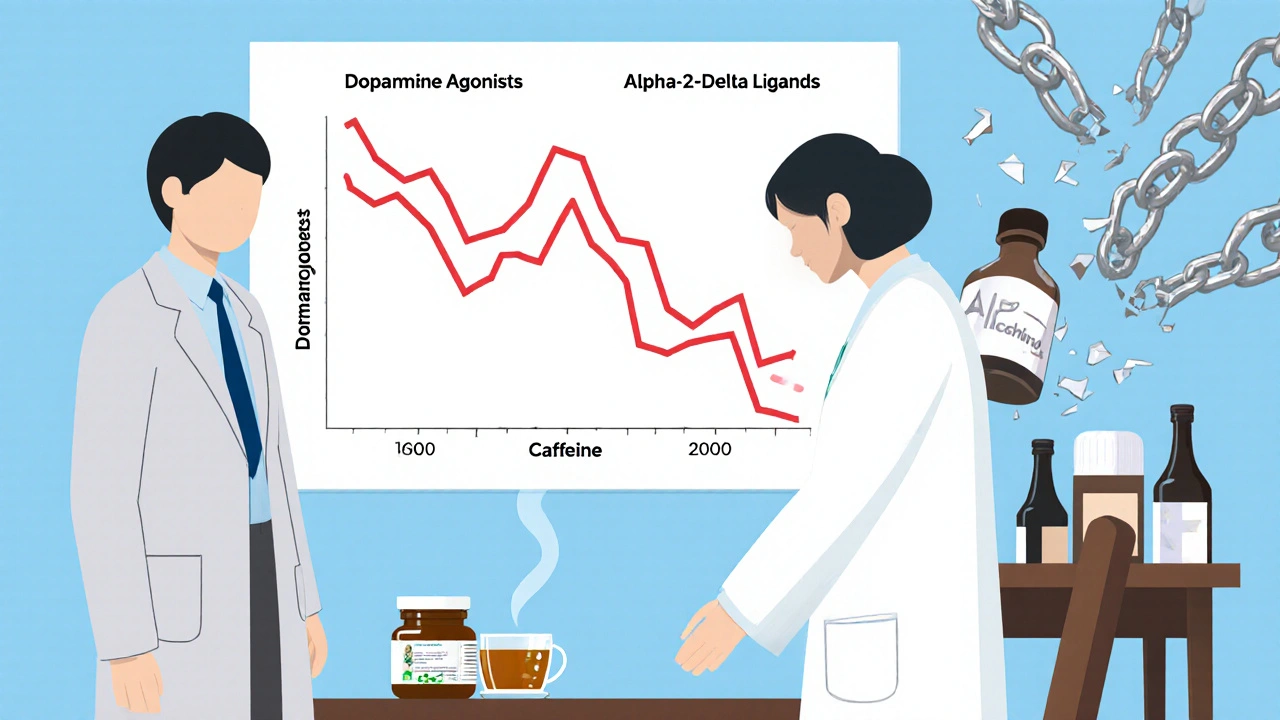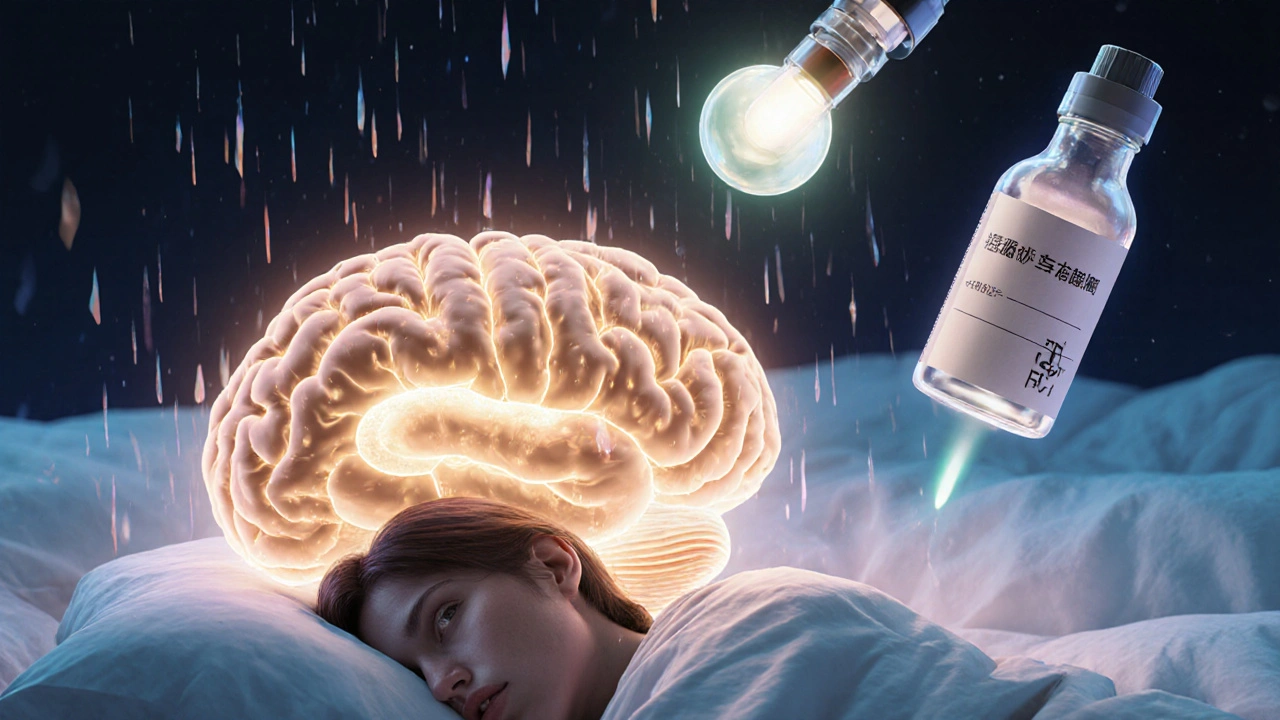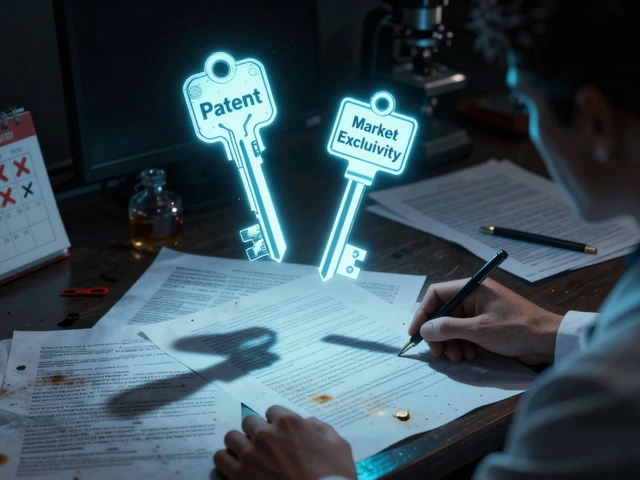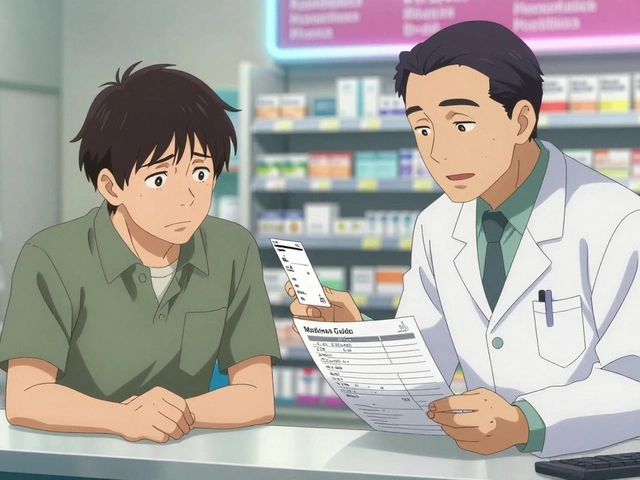
Restless Leg Syndrome (RLS) isn’t just an itch you can’t scratch. It’s a deep, crawling, aching urge in your legs that hits when you’re trying to relax-or worse, when you’re trying to sleep. For millions, it turns nights into battles and days into exhaustion. For years, the go-to fix was dopaminergic medications like pramipexole and ropinirole. But today, the story has changed. These drugs, once hailed as miracle cures, are now seen as risky long-term solutions. The real shift? RLS treatment now leans heavily on safer alternatives that don’t make symptoms worse over time.
What Really Happens in RLS?
RLS isn’t a muscle problem. It’s a brain problem. The issue starts in the A11 region of the brain, where dopamine signals control movement. When dopamine levels dip-or when the brain can’t use it properly-your legs send frantic signals to move. It’s not just discomfort. It’s an irresistible, almost painful urge. Symptoms hit hardest at night, but they can creep into the afternoon as the condition progresses. Women are more likely to have it than men, and it often gets worse with age.
What makes RLS tricky is that it’s not just about dopamine. Research now shows many people with RLS have low iron in their brains-even if their blood iron looks normal. That iron deficiency messes with dopamine production. So treating RLS isn’t just about flooding the brain with dopamine. It’s about fixing the root cause.
Why Dopaminergic Medications Are No Longer First-Line
For decades, drugs like Mirapex (pramipexole) and Requip (ropinirole) were the gold standard. They worked fast. Within an hour, the crawling sensation would fade. But here’s what no one told you: they didn’t fix RLS. They masked it-and made it worse over time.
Augmentation is the silent killer of long-term dopamine therapy. It means your symptoms start earlier. You used to feel them at 10 p.m. Now they hit at 4 p.m. Then at noon. Then they spread to your arms. Your nights go from 3-4 times a week to almost every night. The International Restless Legs Syndrome Study Group found that 40-60% of people on these drugs develop augmentation within 1-3 years. By year five, some studies show rates near 80%.
And it’s not just augmentation. These drugs can trigger impulse control disorders. A 2019 study found 6.1% of RLS patients on dopamine agonists developed compulsive gambling, shopping, or binge eating-compared to just 0.5% in the general population. That’s not a side effect. That’s a life-altering risk.
Dr. John Winkelman, who led the research that exposed these dangers, put it bluntly: “Dopamine agonists, once considered the first-line treatment, are no longer recommended because of their long-term complications.” That’s not a whisper. It’s a guideline change. The American Academy of Sleep Medicine updated its recommendations in December 2024-and it’s now official: dopamine agonists are second-line therapy.
The New First-Line: Alpha-2-Delta Ligands
So what do you take instead? The answer is alpha-2-delta ligands. These include gabapentin enacarbil (Horizant) and pregabalin (Lyrica). They don’t touch dopamine. They calm overactive nerves in the spinal cord. That’s why they don’t cause augmentation.
At 12 weeks, they work just as well as pramipexole. But at 52 weeks? The dopamine drug’s effectiveness drops by 35%. The alpha-2-delta ligand? Still working. No worsening. No spreading. No new compulsions.
Gabapentin enacarbil is FDA-approved for RLS. You take 600 mg once daily in the evening. It’s slow to build up-takes a week or two-but once it does, it stays steady. Pregabalin, used off-label at 75-300 mg daily, works similarly. Side effects? Dizziness and weight gain. But compared to augmentation? That’s a trade-off most patients prefer.
According to IQVIA data from 2024, 65% of new RLS prescriptions are now for alpha-2-delta ligands. That’s up from just 15% in 2015. Neurologists are switching. Patients are switching. The market is shifting.

Other Options: Opioids, Iron, and Lifestyle
Not everyone responds to alpha-2-delta ligands. For those who don’t, low-dose opioids like oxycodone (5 mg) can be surprisingly effective. A 2021 study found 50-70% symptom reduction with no addiction in 99.2% of patients-when used responsibly and under strict monitoring. The key is low dose. High dose? That’s where the danger lies.
Carbidopa-levodopa (Sinemet) is another option, but only for occasional use. It works great for a night out or a long flight. But daily use? It causes augmentation in 70% of patients within six months. So it’s a rescue drug, not a daily fix.
Iron is critical. If your ferritin level is below 75 mcg/L, oral iron (100-200 mg elemental iron daily) can cut symptoms by 35% in 12 weeks. Many doctors skip this step. Don’t. Get your iron checked. It’s simple, cheap, and often overlooked.
Lifestyle changes aren’t optional-they’re essential. Caffeine? It worsens symptoms in 80% of RLS patients. Alcohol? 65% report worse symptoms after drinking. Sleep hygiene matters. Regular exercise helps. Stretching before bed reduces nighttime movement. These aren’t “nice-to-haves.” They’re part of the treatment plan.
What to Do If You’re Already on Dopamine Agonists
If you’ve been on pramipexole or ropinirole for more than six months and your symptoms are getting worse, you’re not imagining it. You’re experiencing augmentation. Don’t panic. Don’t stop cold turkey. Work with your doctor.
Here’s the safe path:
- Start an alpha-2-delta ligand like gabapentin enacarbil at a low dose.
- Slowly reduce your dopamine agonist by 25% every 1-2 weeks.
- Monitor symptoms closely. You may have a short rebound phase-but it passes.
- Test your ferritin level. Start iron if needed.
- Eliminate caffeine and alcohol.
A 2023 study in Sleep Medicine showed 85% success with this approach. People who switched early had fewer withdrawal issues. Those who waited? They suffered longer.

What’s Next for RLS Treatment?
The future is promising. Three new therapies are in phase 3 trials as of 2025:
- A novel iron chelator called Fazupotide, designed to boost brain iron.
- A selective A11 dopamine receptor agonist that avoids triggering augmentation.
- Transcranial magnetic stimulation-a non-drug option that uses magnetic pulses to calm nerve activity.
Market analysts predict dopamine agonist sales for RLS will drop from $360 million in 2024 to $120 million by 2030. Alpha-2-delta ligands? They’ll grow to nearly $900 million. The tide has turned.
Final Thoughts: Stop Digging
RLS is frustrating. It steals sleep. It steals peace. But the old solution-more dopamine-wasn’t a cure. It was a trap. The best relief now comes from smarter, safer, longer-lasting options. Gabapentin enacarbil. Iron. Lifestyle. Even low-dose opioids, when used carefully.
Dr. Winkelman’s advice is simple: “If you find yourself in a hole, stop digging.” If your RLS is getting worse on dopamine meds, you’re in the hole. It’s not your fault. It’s the treatment. Time to climb out.
Can dopaminergic medications make Restless Leg Syndrome worse?
Yes. Long-term use of dopamine agonists like pramipexole and ropinirole can cause a condition called augmentation, where symptoms start earlier in the day, spread to the arms, and become more severe. Studies show 40-60% of patients develop augmentation within 1-3 years, and up to 80% after five years of daily use.
What are the best medications for Restless Leg Syndrome today?
Alpha-2-delta ligands like gabapentin enacarbil (Horizant) and pregabalin (Lyrica) are now the first-line treatment. They reduce symptoms without causing augmentation. For occasional use, carbidopa-levodopa works well. Low-dose opioids like oxycodone (5 mg) are an option for severe cases when other treatments fail, but require careful monitoring.
How do I know if I’m experiencing augmentation?
Signs of augmentation include symptoms starting earlier than usual (by 2-6 hours), spreading to your arms or hands, becoming more intense, and occurring on more nights per week. If you’re taking a dopamine agonist and notice these changes, talk to your doctor. It’s not a sign your RLS is worsening-it’s a sign the medication is causing harm.
Should I get my iron levels checked if I have RLS?
Yes. Many people with RLS have low brain iron, even if their blood iron looks normal. A serum ferritin level below 75 mcg/L is a strong indicator that iron supplementation could help. Studies show 35% symptom improvement after 12 weeks of taking 100-200 mg of elemental iron daily.
Can lifestyle changes help with RLS without medication?
Absolutely. Eliminating caffeine can reduce symptoms in 80% of people. Reducing alcohol intake helps 65%. Regular exercise, stretching before bed, and improving sleep hygiene can cut symptom severity by 20-30%. These aren’t just tips-they’re proven parts of effective RLS management.
Are there new treatments for RLS on the horizon?
Yes. As of 2025, three phase 3 clinical trials are underway: a new iron-targeting drug called Fazupotide, a selective dopamine receptor agonist designed to avoid augmentation, and transcranial magnetic stimulation as a non-drug therapy. These could offer better, safer options in the next few years.







12 Comments
This post hit me right in the feels-been on ropinirole for 4 years and just realized my legs have been screaming at 3 p.m. instead of midnight. I thought I was getting worse. Turns out the meds were making me worse. Holy crap.
I cried reading this. I thought I was just lazy or stressed. Turns out my brain was betraying me-and my doctor never warned me about augmentation. Thank you for putting this out there.
Iron levels are everything. I had ferritin at 22, started 65mg elemental iron daily, and within six weeks my symptoms dropped by half. No meds. Just iron. Why don’t more doctors check this first?
Let me tell you about my journey-so many layers here. I was on Mirapex for five years, started getting restless arms, then couldn’t sit through a movie without needing to pace. My husband thought I was losing my mind. Then I read about alpha-2-delta ligands, switched to gabapentin enacarbil, and suddenly-sleep. Not perfect, but real. I didn’t know how much I’d been suffering until I stopped. And yes, the dizziness was real at first. But it faded. And the guilt? Gone. I’m not broken. The drug was the problem.
Wow, you guys are so naive. You think gabapentin is safe? It’s just a different kind of trap. FDA-approved doesn’t mean FDA-perfect. And iron? You think oral iron fixes brain iron deficiency? LOL. The blood-brain barrier doesn’t care about your ferritin levels. You need IV iron, and even then, it’s not guaranteed. And don’t even get me started on opioids-5mg oxycodone? That’s a gateway to addiction if you’re not a neurologist with a PhD in sleep medicine. 😏
You got this. Seriously. Switching meds is scary, but you’re not alone. I did it last year. It’s a grind, but the peace you get at night? Worth every sleepless night getting off the old stuff.
Let’s be real-this isn’t just about meds. It’s about how medicine has been selling quick fixes for decades while ignoring root causes. Dopamine agonists were marketed as a miracle because they were profitable, not because they were wise. We’ve been trained to swallow pills instead of asking why the brain is starving for iron, why caffeine is a silent enemy, why sleep hygiene is treated like a lifestyle blog suggestion instead of a medical necessity. The shift to alpha-2-delta ligands isn’t just a change in guidelines-it’s a quiet rebellion against pharmaceutical reductionism. And the fact that 65% of new prescriptions now reflect this? That’s not market data. That’s patients waking up. We’re not just treating symptoms anymore. We’re treating the system.
As someone who’s lived with RLS since my 30s and now in my late 50s, I can confirm: dopamine agonists were a disaster for me. Augmentation hit hard-arms, then chest, then my jaw felt it. I was prescribed oxycodone as a last resort, and at 5mg nightly, it was life-changing. No euphoria. No cravings. Just quiet. My GP was nervous, but my neurologist said, ‘If it works and you’re not abusing it, it’s not addiction-it’s management.’ I’ve been on it for three years. Still sleeping. Still sane.
There’s a deeper truth here: RLS is not a disease of the legs. It’s a disease of disconnection-from sleep, from self, from the body’s quiet signals. We treat it like a glitch in the system, but maybe it’s a whisper from the body saying: ‘You’re not listening.’ Iron, caffeine, stress, sleep-all these are threads. Pull one, and the whole tapestry shifts. The real breakthrough isn’t a new drug. It’s learning to listen.
Start with iron. Test ferritin. Then cut caffeine. Then try gabapentin. Don’t skip steps. I did all three and haven’t touched dopamine meds in 18 months. No augmentation. No regrets.
From a clinical perspective: the pharmacokinetics of gabapentin enacarbil offer superior sustained release compared to pregabalin, which has a shorter half-life and more frequent dosing. This translates to more stable nocturnal symptom control. Additionally, the iron deficiency in RLS is likely linked to dysregulation of the DMT1 transporter in the substantia nigra-hence oral iron’s variable efficacy. IV iron in ferritin-deficient patients shows more robust CNS penetration, though access remains limited. This is why the new phase 3 iron chelator, Fazupotide, is so promising-it’s designed to cross the BBB and upregulate ferroportin expression. This isn’t just treatment evolution. It’s neurochemical precision.
Thank you for this. I’m from Nigeria and had no idea this was even a thing here. I thought it was just bad nerves. I told my cousin who has RLS-she got her iron checked last week. Ferritin was 18. Now she’s on supplements. We’re all learning. This post saved her sleep.